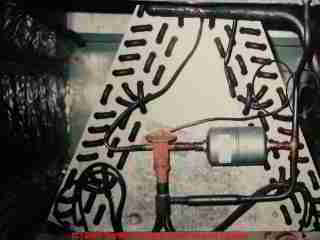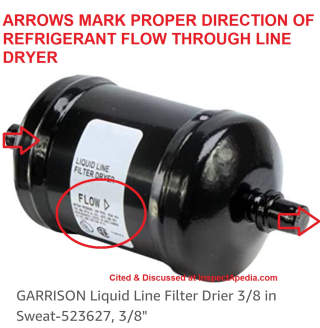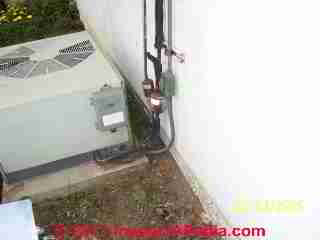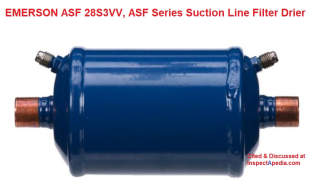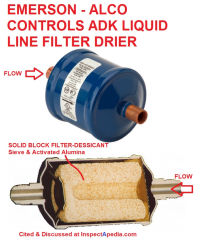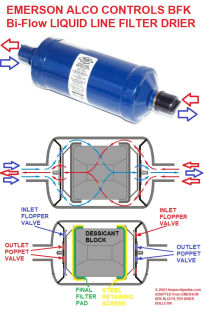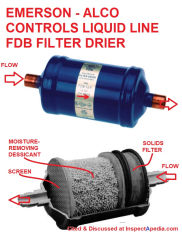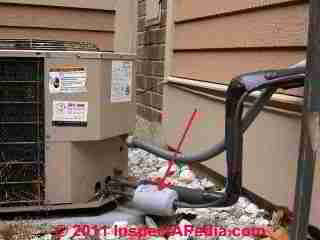 Air Conditioning & Heat Pump Refrigerant Drier / Filter Guide
Air Conditioning & Heat Pump Refrigerant Drier / Filter Guide
- POST a QUESTION or COMMENT about the need for and installation of filter drier canisters on air conditioners & heat pumps
Refrigerant filter drier canisters:
This article discusses when, where, how and why refrigerant driers are installed on refrigeration, air conditioning and cooling systems. Our photo at page top shows the typical location of a refrigerant dryer canister at the compressor/condenser component of a split system air conditioning system.
InspectAPedia tolerates no conflicts of interest. We have no relationship with advertisers, products, or services discussed at this website.
- Daniel Friedman, Publisher/Editor/Author - See WHO ARE WE?
Installing a Refrigerant Dryer / Filter Unit on the Air Conditioning or Heat Pump Refrigerant Line
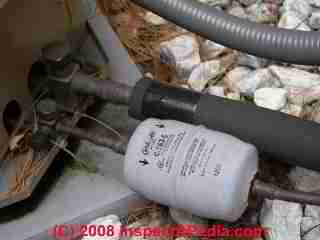
There are several different types of refrigerant piping system filter-drier canisters, installed on the high-side liquid lien or on the low-side suction line, depending on filter type and application.
- Liquid line refrigerant line filter drier on the compressor outlet side, the high pressure refrigerant or liquid line
- Suction line refrigerant filter drier installed on the compressor inlet side, the low pressure refrigerant line
- Heat pump Bi-Directional refrigerant filter drier, installed on heat pump systems are bi-directional, because the refrigerant flow reverses direction depending on whether the unit is in heating mode or cooling mode - as we illustrate later on this page.
Heat pump refrigerant filter-driers are designed using internal check valves to assure that contaminants captured in the filter during the flow of refrigerant during a heating cycle are not relased back into the refrigerant when flow direction reverses during a cooling cycle and vice-versa. - Replaceable Cartridge Dual-Purpose refrigerant compressor burnout filters in special models like the Emerson STAS Steel Take Apart Shell filter drier can be installed either on the liquid line or on the suction line.
Our photo shows that a Catch-All™ C-163_S refrigerant dryer and filter has been installed on the high pressure refrigerant line leaving the outdoor compressor/condenser unit.
This is where we usually see the high pressure refrigerant line filter-drier device installed.
Notice that a refrigerant dryer, which removes un-wanted moisture from the refrigeration system, is labeled with the types of refrigerant with which it is designed to be used.
Once an air conditioner or heat pump system refrigerant leak has been repaired, it will be necessary to flush the refrigerant piping system (usually using nitrogen), pull a new vacuum on the system, and then re-charge the system with the proper type and quantity of refrigerant.
Where subsequent work has been done on a heat pump or air conditioning systems such as replacing a burned-out compressor, a suction line filter drier should be installed on the suction line just ahead of the compressor to protect the compressor from contaminants.
Article Contents
- REFRIGERANT DRIERS & FILTERS
- REFRIGERANT FILTER DRYER LOCATIONS
- REFRIGERANT FILTER DRYER INSTALLED INDOORS
- REFRIGERANT FILTER DRIER Applications, Installation Details, & Warnings
- REFRIGERANT FILTER DRYER TYPES & INSTALLATION RULES
- REFRIGERANT DEBRIS FILTERING
- COMPRESSOR BURNOUT FILTERS DRYERS
- LIFE EXPECTANCY of a REFRIGERANT FILTER DRYER
- REFRIGERANT LINE FILTER DRIER INSTRUCTIONS
What is that grey canister you see at an air conditioning component: why are driers and filters installed on refrigeration equipment? When is a refrigerant gas drier usually installed;
Where should the refrigerant drier be installed on refrigeration equipment; Special refrigerant drier/filter for use when a compressor motor has been replaced.
Diagnosing a saturated or dirt-clogged refrigerant drier canister; How to fix air conditioning or refrigerator refrigerant gas leaks
Where is the Refrigerant Drier Located on HVAC Systems?
Carson Dunlop Associates' sketch illustrates where the filter/dryer is most often found at air conditioning or heat pump equipment: on the liquid refrigerant line, in one or more of these locations:
- outside, near the condenser unit (see sketch at left)
- inside near the evaporator coil, ahead of the thermostatic expansion valve or capillary tube
- at both of the above locations, and possibly even on the suction line on a system at which a burnt-out compressor motor has been replaced
Most HVACR refrigerant filter-driers are designed to be soldered in place, as is the unit shown at left. Some driers may permit connection using flare fittings - a connection we consider less secure and more leak prone.
When a refrigeration system is or has been "open" - has been emptied of refrigerant for re-charging, for example, the last repair step before re-charging the repaired air conditioning or heat pump system with refrigerant is to install a filter/drier such as shown in our photo at left.
The purpose of a refrigerant drier is to absorb (and thus remove) moisture in the refrigeration system. The effects of moisture on refrigeration systems are detailed at REFRIGERANT LEAK DETECTION but in sum we can say that moisture in the system can prevent proper operation and can even completely stop the system from working at all, even causing costly damage.
We also find a drier installed on refrigeration systems that have been serviced for a refrigeration leak, especially a low-side piping leak, because of the increased chance that the system has been contaminated by moisture and perhaps dirt.
In fact if the system was open and badly contaminated the HVAC technician may install a drier right after the repair and may install a new or second drier on the same system a few months later.
While some technicians always install a filter/drier on the refrigerant system, even at original installation, more often when we see a refrigerant drier canister on a system (usually at the compressor/condenser unit) we assume that the system has undergone some service or repair as that's most often when the device is added.
Refrigerant Drier Filter Installation Positions & Locations on HVACR Equipment
Where is the Drier Usually Located on an Air Conditioning, Heat Pump, or other Refrigeration System?
The drier is installed at the coolest location on the system, on the liquid line, outside of the refrigerated space, and ahead of any refrigerant metering devices like thermostatic expansion valves or capillary tubes.
In our photo (left) you can see that the drier has been installed outdoors, at the point where the high side liquid refrigerant line is exiting the compressor/condenser unit.
In our photo below left you'll see a filter/drier installed in two locations on the air conditioning system compressor/condenser.
Refrigerant filter drier canisters may also be installed indoors
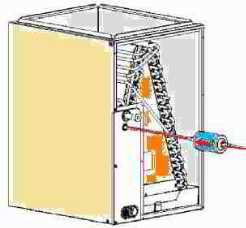 Some air conditioner and heat pump installation instructions specify the installation of a liquid-line filter drier indoors (as well as or in place of outside at the compressor-condenser unit).
Some air conditioner and heat pump installation instructions specify the installation of a liquid-line filter drier indoors (as well as or in place of outside at the compressor-condenser unit).
A typical indoor refrigerant filter/drier location is shown in our sketch at left: see the blue canister with red arrow showing refrigerant direction flow in Carrier's sketch at left (edited)).
- Braze 5 in. (127 mm) liquid tube to the indoor coil.
- Wrap filter drier with damp cloth.
- Braze filter drier to above 5 in. (127 mm) liquid tube.
- Flow arrow must point towards indoor coil.
- Connect and braze liquid refrigerant tube to the filter drier.
Watch out: UNIT DAMAGE HAZARD Failure to follow this caution may result in equipment damage or improper operation. Installation of filter drier in liquid line is required.
- Source: Carrier[5]
Below our photo illustrates the installation of a refrigerant filter/drier at the A-coil - you can see the horizontal drier canister to the right of (and protecting) the tan-colored Thermostatic Expansion Valve (TEV).
Refrigerant Filter Drier Applications, Installation Details, & Warnings
- A factory approved liquid-line filter drier is required on every unit
Always install the factory-supplied liquid-line filter drier. If replacing the filter drier, refer to Product Data Digest for appropriate part number.
Obtain replacement filter driers fromyour distributor or branch. [Carrier installation instructions] - Match the filter/drier to the operating pressure & properties
of the refrigerant gas and equipment on which it is to be installed. For example, on HVACR using Puron® R410-A refrigerant, do not use liquid-line filter driers with rated working pressures less than 600 psig - Do not leave Puron suction line filter driers in line longer than 72 hours
[during initial equipment installation] - Use the correct type of filter drier for the location
at which it is to be installed. Do not install a suction-line filter drier in liquid line. - Do not overheat or damage the filter drier during installation.
For example installation instructions typically call for the filter drier to be wrapped in a wet cloth during brazing of its connections to the refrigerant tubing or piping. - When air conditioner or heat pump refrigeration system must be opened for service,
recover refrigerant, evacuate then break vacuum with dry nitrogen and replace filter driers. Evacuate to 500 microns prior to recharging.
Source: PURONR (R--410A) REFRIGERANT QUICK REFERENCE GUIDE-[5]
Check the Refrigerant Filter Drier Type & Installation Location / Position
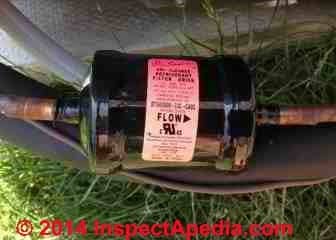 Watch out: be sure to check the installation instructions for your specific HVAC equipment before installing a filter-drier.
Watch out: be sure to check the installation instructions for your specific HVAC equipment before installing a filter-drier.
Watch out: Do not install a suction-line filter drier in liquid line. (Carrier 2016)
And be sure that you are installing the proper type of filter-drier, intended for use on a suction line or on a liquid refrigerant line.
For example, some newer equipment such as the 24 ANA Infinity™ Series Air Conditioners with Puron® Refrigerant, include instructions that state:
- Do not use liquid--line filter driers with rated working pressures less than 600 psig.
- Do not leave Puron suction line filter driers in line longer than 72 hours.
- Do not install a suction-line filter drier in the liquid line.
- Wrap all filter driers and service valves with wet cloth when brazing.
- A factory approved liquid--line filter drier is required on every unit. [1]
Refrigerant Line Dryer Filter Flow Direction
Refrigerant Debris Filtering Requirements
Our photograph illustrates the installation of filter driers on both the liquid refrigerant line and the gas "suction line" at an outdoor compressor-condenser unit.
Watch out: the filter drier types are not identical - the proper filter/drier type must be matched to its location and use on liquid versus gas refrigerant piping.
Refrigerant Driers not only remove moisture, they also are intended to filter debris from the refrigerant piping system.
Filtering the refrigerant liquid leaving the compressor/condenser protects the Thermal Expansion Valve or capillary tube from clogging. In at least some refrigerant drier/filter models, the presence of the strainer means that the drier/strainer device has to be installed in a particular direction such that particles of the desiccant do not break free and travel through the refrigerant piping system.
In our air conditioner compressor / condenser unit photo (left) you can observe that two refrigerant filter-driers are installed, one on the low side and one on the high side. The suggestion is that repair work has been done on this system, possibly a compressor replacement.
Compressor Burnout Filter Driers: Why is a filter-dryer critical on an air conditioner or refrigeration system that has been worked-on?
Water anywhere inside the refrigerant handling system (tubing, compressor, condenser, or refrigerant metering cap tube or thermostatic expansion valve) freezes, making the system inoperative. The inside of any refrigeration system must be pure refrigerant: no air, no dirt, no water, and no mix of various refrigerant gases other than a single gas for which the system is designed.
Watch out: above we mentioned that on a badly contaminated refrigeration system the technician may install a new or a second drier a few months after the original repair/service. If a drier has become saturated in the course of doing its job (of removing moisture from the refrigerant system), it begins to restrict the flow of refrigerant through the system.
This refrigerant flow restriction will cause pressure changes indicated by a temperature difference on either side of the drier - that's one way you could quickly test for a clogged refrigerant drier.
Watch out: if you change the size of the drier that you have installed on a refrigeration system that does not use a refrigerant receiver (as is the case with most residential appliances and air conditioners/heat pumps, you will have to compensate in the charge used in the system (if it is a "critically-charged" or precise charge system as we've discussed here).
For example if you install a larger drier than was previously in place you'd need more refrigerant charge in order to assure that the frost line will still extend to the end of the evaporator.
Special Burnout Filters Used after a Compressor Motor Replacement
A "burnout drier" is a special drier installed on the suction line in refrigeration systems when a compressor motor has burned out and the compressor is changed out.
The filter protects the new refrigeration compressor from damage due to debris, particles, moisture, and even inorganic acids that may be in the refrigerant piping system after a compressor motor has "burned out".
But good practice will install this filter-dryer ahead of the compressor after any major work is done on the air conditioning or heat pump system that involves opening its refrigerant piping system.
In this case we have to first clean the acid and lacquer out of the refrigeration system. (Using Karene-R11).
The system is washed out and then the burnout drier is put in temporarily in the low side or "suction side" or return refrigerant line, replaced one or more times as needed, until the system is cleaned. Therefore you might not normally see a drier in this position on a system except during that repair process.
The burnout filter drier is a special unit able to remove acids and contaminants that were created when the old compressor burned out. These driers also usually provide the ability to compare pressures across the device. If the filter/drier is clogging and thus causes a reduced pressure on the suction side, the compression ratio in the compressor increases, compressor efficiency drops, and in extreme cases the equipment could be damaged.
Watch out: experts warn that the suction line dryer is not only important, but that it must be sized properly to match the system's design flow rate of refrigerant.
- If refrigerant flow velocity is too slow
(caused an oversized dryer) the return of oil to the compressor may be hindered and the compressor could be damaged. - If the refrigerant line dryer is too small
(under-sized) the result is an un-wanted pressure drop on the compressor side of the dryer, causing lower suction pressure, higher compression ratios, and a less efficient-operating HVACR system. - Whitman et als. (xxxx) p. 501-502
See REFRIGERANT HIGH HEAD PRESSURE DIAGNOSIS
More details about what moisture and contaminants do to a refrigeration system are discussed
What is the Life Expectancy of a Refrigerant Filter Drier Installed on an Air Conditioner or Heat Pump or Refrigerator/Freezer?
Reader question: what is the life expectancy of a filter dryer canister on refrigeration equipment?
Martin Chan
Hi! I was wondering how long is the life expectancy of the dryer filter? Once fixed, how do we know when to change a new one ? Are there any reasons for changing a drier filter ? Could I run a VRV system without the use of a drier filter ? What is the difference between installing a drier filter and not installing, for a VRV system ?
Reply:
Martin I have several different answers to the question of refrigeration system filter-drier life:
A filter drier that is installed as good practice or precaution on a healthy HVACR system is left in place often for many years, even the life of the equipment.
A filter drier that was installed (usually two of them) following replacement of a burned-out compressor is often changed after a year, on the theory that it may have collected a fair amount of crud that ought to be removed to avoid risking blocking refrigerant flow. After that swap out the new filters are left in place indefinitely unless the technician finds a reason to do otherwise.
After those standard cases, on occasion a refrigerant filter drier MIGHT be removed and replaced if tests on the system showed that it is clogging.
Ordinarily a drier should last the life of the equipment, given no leaks or problems with the system that require that the refrigerant piping be cut.
(The piping will be cut and the system opened, for example, if a cooling coil or condensing coil has to be replaced.)
Short term temporary use refrigerant line filter-driers
Watch out: some filter driers installed on refrigerant piping have special short-term intended uses such as during new equipment installation or when used as a compressor burnout filter drier. E.g. Carrier's new equipment installation instructions state
Do not leave Puron suction line filter driers in line longer than 72 hours. [1]
Refrigerant Line Dryer Installation Instructions
How does a suction line or liquid line refrigerant filter drier work, and what's inside these (usually sealed) filter canisters? How does a bi-directional refrigerant filter work on heat pump systems?
See the illustrations and photos given below.
Illustration: Emerson ASF Filter-Drier cited & discussed below and also above on this page.
[Click to enlarge any image]
- Carrier, SINGLE STAGE COMFORT AIR CONDITIONERS INSTALLATION INSTRUCTIONS [PDF] Carrier Corporation, 7310 W. Morris St. S Indianapolis, IN 46231 USA
Includes details about the filter dryer installation requirements for Carrier systems.
Excerpt: Do not install a suction--line filter drier in liquid line. - Emerson, ASD SUCTION LINE FILTER-DRIERS INSTRUCTION SHEET [PDF] (2013) Suction Line Filter-Driers:
ASF/ASD/SFD/A-TS/ASK, Emerson Electric Co., Website: www.EmersonClimate.com/FlowControls, Tel - Technical Support: 1-866-625-8416, - retrieved 2021/06/18 original source: https://climate.emerson.com/documents/suction-line-filter-driers-asf-asd-sfd-a-ts-ask-instructions-en-3585830.pdf
Excerpt:
Emerson suction line filter-driers incorporate a protective filter, plus desiccant blended for maximum moisture and acid removal. Compressor manufacturers recommend the installation of suction line filter-driers to protect their equipment from contaminants left in the system after a burnout.
These suction line filter-driers include protection from moisture and organic or inorganic acids, resulting from burnouts, or chemical changes in the system refrigerant or oil. They are specially suited for system clean-up after a burnout, or when major work has been performed on the system.
Illustration above: Emerson Alco Controls' ADK liquid line drier illustrating use of a solid block internal filter, cited below.
- Emerson Alco Controls ADK LIQUID LINE FILTER DRIER TECHNICAL BULLETIN [PDF] Alco Controls, Emerson, Op. Cit., - retrieved 2021/06/18 original source: https://climate.emerson.com/documents/adk-filter-driers-technical-bulletin-en-gb-4540766.pdf
This liquid line filter drier uses a solid block drying material that filters particulates and also removes moisture. The company says that
The active drying material is in the form of a solid block. The solid block is a mixture of molecular Sieve and activated Alumina for maximum moisture and acid removal capacity ... formed into a solid block and held together by a synthetic binding material.
Illustration above: Emerson Alco Controls' BFK Bi-Flow liquid line refrigerant filter drier used on refrigeration systems whose refrigerant flow direction is bi-directional and reversing, such as on heat pump units. Cited just below.
[Click to enlarge any image]
- Emerson Alco Controls BFK LIQUID LINE BI-FLOW FILTER DRIER for HEAT PUMPS Technical Bulletin [PDF] used on the liquid line in reversible refrigeration systems - refrigerant reverses flow direction.
Illustration: Emerson FDB Liquid Line Filter Drier cutaway showing the filter's construction, excerpted from the FDB liquid line filter drier bulletin cited just below.
- Emerson FDB LIQUID LINE FILTER DRIER Technical Bulletin, [PDF] Alco Controls, Emerson, Op. Cit., - retrieved 2021/06/18 original source: https://climate.emerson.com/documents/fdb-filter-drier-technical-bulletin-en-gb-4686690.pdf
This liquid line filter uses a more-complex interior structure to combine an upstream-side particle filter with a loose bead filled desiccant stage on the filter's downstream side.
- Emerson STAS TAKE-APART FILTER-DRIER INSTRUCTIONS [PDF] Emerson Climate Control, Op. Cit., compressor burn-out filter.
The STS filter can be taken apart to replace an internal filter/drier; the STAS is used on the liquid OR on the suction line in a refrigeration system following a compressor burnout and replacement.
On the liquid line the STAS Compressor Burn-Out filter is best-installed between the receiver and the moisture-liquid indicator, solenoid valve and TEV (expansion valve). On the high side liquid line the filter shell can be mounted in any position but the horizontal position is preferred to make cleaning easier.
On the suction line the STAS Compressor Burn-Out filter is installed as close as possible to the compressor but "upstream" from any vibration eliminator (if present). On the suction side the filter shell is installed in a vertical or pitched position to permit oil to return to the compressor.
Watch out: the company notes that The side connection of the STAS shell must always be the inlet when used on liquid line service to ensure system protection from possible block rupture. - Imperial Clevite, "Instructions for Kwik-Charge" ™ provided by Imperial Clevite, Inc., Fluid Components Division, 6300 West Howard St., Chicago IL 60468 (July 1982 device instructions)
- Robinair® Robinair Manufacturing Corporation, Robinair Way, Montpelier OH 43543-9990 or more currently: OTC/SPX
655 Eisenhower Drive
Owatonna, MN 55060 USA
Phone (507) 455-7000
Fax (507) 455-8354. Customer service Tel: 800-628-6496. Technical support: 800-822-5561. Website: http://www.robinair.com/
Robinair provides a wide range of refrigerant charging equipment including gauges, hoses, automatic charging scales, and refrigerant recovery/recycling equipment. - Robinair® Dial-a-charge charging cylinder description and instructions, Kent-Moore Robinair Manufacturing Corporation, Robinair Way, Montpelier OH 43543-9990 or more currently: OTC/SPX
655 Eisenhower Drive
Owatonna, MN 55060 USA
Phone (507) 455-7000
Fax (507) 455-8354. Customer service Tel: 800-628-6496. Technical support: 800-822-5561.
Robinair provides a wide range of refrigerant charging equipment including gauges, hoses, automatic charging scales, and refrigerant recovery/recycling equipment. - Parker Sporlan REFRIGERANT DRYER INSTALLATION INSTRUCTIONS [PDF] Sporlan Division, Parker Hannifin Corporation
206 Lange Drive, Washington, MO 63090 USA Tel: 636 239 1111 Website:
www.sporlan.com retrieved 2021/06/18 original source: https://sporlanonline.com/literature/40/SD-214.pdf
Installation and servicing instructions for Sporlan's replaceable core catch-all filter-drier.
Excerpt:
The drier shell may be installed in any position, but always observe the proper flow direction. A horizontal position is usually most convenient, since any dirt collected on the cores will not drop into the outlet fitting when the cores are removed. - Parker Sporlan, HOW THE REVERSIBLE HEAT PUMP FILTER-DRIER WORKS [PDF], Op. Cit., retrieved 2021/06/18 original source: https://www.parker.com/literature/Sporlan/Sporlan pdf files/Sporlan pdf 040/SD-111_CA Rev Heat Pump Install72015.pdf
...
Reader Comments, Questions & Answers About The Article Above
Below you will find questions and answers previously posted on this page at its page bottom reader comment box.
Reader Q&A - also see RECOMMENDED ARTICLES & FAQs
On 2020-06-24 by Laszlo - What happens if a filter drier is installed after EXV?
What happens if a filter drier is installed after EXV? for example to 1/4 line of a split AC before the indoor unit.
On 2020-06-24 - by (mod) -
Laszlo
I don't think it's an issue; after all, it's common to find a filter-drier installed on both high and low sides of a refrigeration system.
On 2020-06-25 by Laszlo - After charging the system, I heard that ice balls are running and suction pressure dropped to vacuum
Thank you for your fast reply. Yesterday I tried it, with a Castel 4308/2. Long story short: I have a small DIY project, modifying a mini-split to a water-cooled condenser type. Old 407c outdoor unit, without gas. I had found some old 407c at home, but it was contaminated with water/moisture.
After charging the system, I heard that ice balls are running and suction pressure dropped to vacuum sometimes. Since I don't have more 407c (and don't want to buy for this hobby project), I wanted to clean it.
So I put the filter after EXV, vacuum the indoor and tubes. After startup, I heard that ice balls are hitting the filter. suction pressure was going up and down. after 10-15 minutes, noises stopped, the pressure got constant.
Just there was no cooling capacity at the indoor unit. I removed the filter, connected the tubes, vacuum it. startup: and it's working properly! So it's possible to use it, but just temporary until the system is cleaned. Maybe this could be helpful for others.
On 2020-06-25 - by (mod) -
If your charge or refrigerant is incorrect you might be getting too much frost on the evaporator coil - that can block air flow and cut cooling.
On 2017-10-22 by Paveen - should the filter drier be ahead of the expansion valve?
Sir,can you advice me ..if expansion takes place in outdoor unit..means cooling coil starts from there..normally it should be before expansion valve.
.but in this case if input it in the cooling line ..will it result in pressure drop/ cooling efficiency..?
On 2017-10-22 - by (mod) -
Paveen,
Because the filter drier is designed to function without causing a pressure drop across the filter it should not matter where a properly-selected and sized filter drier is installed.Often after a compressor burnout replacement (for example) the tech will install a filter drier in two locations, as described in the article above.
On 2017-06-14 by Brian - Would you fellows really install a filter-drier out side of the AC box?, particularly here in Florida?
Brian
Would you fellows really install a filter-drier out side of the AC box?, particularly here in Florida?
Look at the photos of my rusted out one that is ONLY 5 years old
(mod) said:
Thank used for the excellent comment, Brian. It's clear that the installation details for filter driers should vary depending on climate and other site situations.
We could not look at your photos as to do so requires opening an account at the refrigeration engineer photo host.
There your comments included
I have a 5.5 year old York (Luxaire) unit hooked up to my trailer home here in St Augustine Fl. I do NOT live near the beach. I keep my whole trailer and surrounding property very clean and washed down.
"A week ago I lost all refrigerant from my AC unit. At fault was a VERY RUSTY filter/drier that ended up letting all the refrigerant escape.I looked up the manufacturer of this filter-drier (Sporlan) and found they were a USA company, who had been in this business since the late 1940's. They were NOT a Chinese company that I would have been immediately suspicious of manufacturing such a substandard product.
Take a look at this filter-drier (some photos attached), and give me your opinion. My opinion is that this filter-drier was NOT properly undercoat painted/prepared prior to the outer paint coating. The water readily got under that outer coating (paint layer) and the rust began from day one. Look at how that outer layer just peels off in layers while still holding together as an entity. " - op. cit.
You are welcome to use our page bottom or top CONTACT link to find our email to send me photos of the conditions you are describing, and I'll be glad to comment further.
I add that a review of ten Sporlan and other filter-drier installation instruction sets did not discover any instruction that discusses a required location inside or outside of the equipment covers or exposed or not exposed to the weather.
Other causes of corrosion on a filter drier might be exposure to salt spray (sea side installations), deicing salts in some climates and locations, and electrical wiring defects.
Watch out: when you find unusual corrosion on HVAC equipment it is worth having some electrical grounding system inspection and tests by an experienced electrician: a grounding error can cause accelerated corrosion or other damage to HVACR equipment - AND - improper electrical grounding or neutral wiring is dangerous, risking shock or fire hazards too.
On 2015-09-21 by Penny
Should the drier be changed if a new air handler is installed?
On 2015-09-21 by mod
Yes because we'll have to cut and restore the refrigerant piping.
On 2015-06-15 by Anonymous - hvac tech said we don't need a filter drier
My heating and air conditioning person didin't like the look of the canister and said we didn't need it.
On 2015-06-15 - by (mod) -
what canister?
If you mean the refrigerant filter-drier, yes normally it's good practice to leave that component in place or to install a new one if the system refrigerant piping has been cut open or a compressor replaced.
Question / Comment: Failure to install a burnout filter/dryer may have led to early failure of the replacement unit
After a contractor replaced a failed compressor ) that failed via acid burnout) he left in the 16 year old suction line filer,,,he never put in a burnout filter at all....the compressor failed in just 13 months they normally last 18 plus years. I think he should refund the 42,000 he charged me what do you think.
When I asked the contractor to explain his substandard work he said I can't prove 100% that the dirty gunked up suction line filter caused the 3 1/2 ton Copland compressor to fail ,,,what a joke. - Tom Morris
Reply:
Tom, we agree with you. Good practice would have been to install a burnout dryer-filter on the system and perhaps, depending on how dirty the system was from the first burnout, to return and swap in a second filter unit after a period of time. The cost to the tech to come back to make that second change is not trivial however, and both owner and tech are tempted to skip it. The risk is clogging of the thermal expansion valve or other parts in the future, leading to still more repairs.
But I wouldn't assume that the prime or only cause of failure of the replacement compressor was just due to the dryer omission. A tech who doesn't know about the importance of all of the steps in replacing a burned out A/C or heat pump compressor may not have known other important steps to take.
Question: Where does the refrigerant drier/filter go?
Dan,
Regarding installation of a filter/dryer; the filters I have seen on HVAC parts sites are for installation on the suction side. When I installed an AC in my house in '88, I installed a filter/dryer in the liquid line, near the coil as recommended at the time.
It seems to me that it makes more sense to filter the liquid entering the TXV than to filter the gas entering the compressor. What am I missing? I purchased the compressor on eBay.
It turns out that it was exactly the P/N specified in the parts list for the equipment. The gaspack contained what I assume was an earlier equivalent part. - Doug
Reply:
Doug we see filter dryers installed at both sides of the compressor. It depends ... if a system is thought to be contaminated there are advantages of having a filter at both ends of the compressor motor, and it certainly doesn't hurt.
Question: new condenser installed, does the drier have to be replaced?
(Aug 23, 2012) Susan
I had a new condensing unit put in. Does the installer need to come out after a month and put in a new dryer? Is it a suction or line dryer?
Reply:
Susan,
IF the old compressor burned up it's good practice to change out that filter drier as you suggest, though often the tech may leave the burnout filter drier in place for a longer interval before changing it. It depends on the type of dryer and where it was installed.
Watch out: Do not leave Puron suction line filter driers in line longer than 72 hours. [1]
Question: does the external filter dryer lose refrigerant?
(May 12, 2014) Bob Gorman
Having installed External filter dryer. will they lose the refrigerant during installation and will have to be replaced?
Reply:
Bob, filter-drier canisters do not lose refrigerant and are replaced as per discussed in the article above. If the HVACR technician follows good procedure while connecting her test equipment, gauges, charging cylinder etc. to the system refrigerant is not "lost" in the procedure such that adding refrigerant would be needed.
Question: annoying whistling sound from AC at start-up and shut down in cooling mode
(June 2, 2014) Dave
I have a rheum heat pump installed new in 09 was fine till last year. Unit started making a whistle noise only on ac start up and shutdown not heat mode. Had 410a charge checked and about a pound was added. Noise was now less but he came back and added a little more 410a --- no change in noise.
Then ran heat pump a few months later and it shutdown on high pressure---suspect too much 410a ? Came back and let some out using the gauge set. Runs on heat pump now and ac but still make noise. Unit is in a condo / coil & or evaporator gas noise surging in line till it equalizes ? Very annoying at night. Did not do this for the first 3 years any ideas ? He doesn't know what to do & either do I.
Reply:
Dave
Take a look at
inspectapedia.com/noise_diagnosis/HVAC_Noise_Descriptions_5.php#Whistle
and let me know if that helps.
Question: liquid line filter dryer found on the gas or suction line
(June 9, 2014) Grace
What happens if your compressor may need to be replaced due to liquid line dryer being found in the hot gas line? Can the compressor be saved? Thank you!
Reply:
Grace:
A Suction Line filter drier is installed to protect the compressor against damage and its installation is good practice. After a compressor burnout, because there is extra risk of contaminants in the refrigeration piping system, a special burnout filter dryer, capable of filtering out acids, is installed to protect the new copressor.
If we omit the burnout filter/dryer the risk is that we contaminate, damage, or reduce the life of the new compressor.
At this point of discovery of the error you cite, the right move is to install the proper filter dryer. If the system is working normally that's the best we can do, though you might discuss a dealer-supported extended warranty if the installer accepts responsibilty for the original error.
Question: filter dryer installed backwards
6/17/2014 edmund magras
A company installed a dry filter backward. It went un-noticed for about a year before it was replaced should I be concerned
ejmagras@hotmail.com
Reply:
Edmund,
The backwards drier itself won't cause damage to your system, but it may not have been filtering properly, leaving a risk of debris-clogging of the refrigerant metering device or other components. If those had clogged you'd know it because the system would not be working properly
Therefore my OPINION is that if the drier is now installed properly you're ok.
...
Continue reading at REFRIGERANT LEAK DETECTION or select a topic from the closely-related articles below, or see the complete ARTICLE INDEX.
Or see these
Recommended Articles
- LOST COOLING CAPACITY
- PRESSURE CONTROLS & SAFETY SWITCHES
- REFRIGERANT GASES & PIPING - home
- FROST BUILD-UP on AIR CONDITIONER COILS
- GAUGE, REFRIGERATION PRESSURE TEST
- HVAC COMPRESSION RATIOS
- REFRIGERANT CHARGING PROCEDURE
- REFRIGERANT DRIERS & FILTERS
- REFRIGERANT FLOODBACK, LIQUID SLUGGING
- REFRIGERANT LEAK DETECTION
- REFRIGERANT LEAK REPAIR
- REFRIGERANT LINE FROST or ICE
- REFRIGERANT METERING DEVICES TEVs & EEVs
- REFRIGERANT METERING CAPILLARY TUBES
- REFRIGERANT PIPING INSTALLATION
- REFRIGERANT PIPING GURGLING
- REFRIGERANT PRESSURE DIAGNOSIS
- REFRIGERANT PRESSURE READINGS & CHARTS
- REFRIGERANT UNDERCHARGE EFFECTS
- REFRIGERANT SIGHT GLASS
- AIR CONDITIONING & HEAT PUMP SYSTEMS - home
- SPLIT SYSTEM AC / HEAT PUMP REPAIRS
Suggested citation for this web page
REFRIGERANT DRIERS & FILTERS at InspectApedia.com - online encyclopedia of building & environmental inspection, testing, diagnosis, repair, & problem prevention advice.
Or see this
INDEX to RELATED ARTICLES: ARTICLE INDEX to AIR CONDITIONING & HEAT PUMPS
Or use the SEARCH BOX found below to Ask a Question or Search InspectApedia
Ask a Question or Search InspectApedia
Try the search box just below, or if you prefer, post a question or comment in the Comments box below and we will respond promptly.
Search the InspectApedia website
Note: appearance of your Comment below may be delayed: if your comment contains an image, photograph, web link, or text that looks to the software as if it might be a web link, your posting will appear after it has been approved by a moderator. Apologies for the delay.
Only one image can be added per comment but you can post as many comments, and therefore images, as you like.
You will not receive a notification when a response to your question has been posted.
Please bookmark this page to make it easy for you to check back for our response.
IF above you see "Comment Form is loading comments..." then COMMENT BOX - countable.ca / bawkbox.com IS NOT WORKING.
In any case you are welcome to send an email directly to us at InspectApedia.com at editor@inspectApedia.com
We'll reply to you directly. Please help us help you by noting, in your email, the URL of the InspectApedia page where you wanted to comment.
Citations & References
In addition to any citations in the article above, a full list is available on request.
- TIF Instruments, Inc., 9101 NW 7th Avenue, Miami, Florida 33150 (This is where we've sent our TIF 8800 and TIF 5000 for repairs).
- Air Conditioning, Heating, & Refrigeration Institute, [industry association], Air-Conditioning, Heating, and Refrigeration Institute (AHRI) 2111 Wilson Blvd, Suite 500 Arlington, VA 22201 USA, Tel: 703-524-8800, Email: ahri@ahrinet.org,
- [5] Modern Refrigeration and Air Conditioning, A. D. Althouse, C.H. Turnquist, A. Bracciano, Goodheart-Willcox Co., 1982
- [6] REFRIGERANT PIPING GUIDE [PDF] , Application Guide AG-31-011, McQuay Air Conditioning, Daikin McQuay International Equipment, 13600 Industrial Park Blvd., Minneapolis, Minnesota 55441 USA Tel: 800-432-1342 (Toll Free), Website: http://www.daikinmcquay.com/, [Copy on file as https://inspectapedia.com/aircond/AC_Guide_McQuay.pdf ]
- [7] Principles of Refrigeration, R. Warren Marsh, C. Thomas Olivo, Delmar Publishers, 1979
- [8] "Air Conditioning & Refrigeration I & II", BOCES Education, Warren Hilliard (instructor), Poughkeepsie, New York, May - July 1982, [classroom notes from air conditioning and refrigeration maintenance and repair course attended by the website author]
- [9]Refrigeration and Air Conditioning Technology, 5th Ed., William C. Whitman, William M. Johnson, John Tomczyk, Cengage Learning, 2005, ISBN 1401837654, 9781401837655 1324 pages
- In addition to citations & references found in this article, see the research citations given at the end of the related articles found at our suggested
CONTINUE READING or RECOMMENDED ARTICLES.
- Carson, Dunlop & Associates Ltd., 120 Carlton Street Suite 407, Toronto ON M5A 4K2. Tel: (416) 964-9415 1-800-268-7070 Email: info@carsondunlop.com. Alan Carson is a past president of ASHI, the American Society of Home Inspectors.
Thanks to Alan Carson and Bob Dunlop, for permission for InspectAPedia to use text excerpts from The HOME REFERENCE BOOK - the Encyclopedia of Homes and to use illustrations from The ILLUSTRATED HOME .
Carson Dunlop Associates provides extensive home inspection education and report writing material. In gratitude we provide links to tsome Carson Dunlop Associates products and services.



